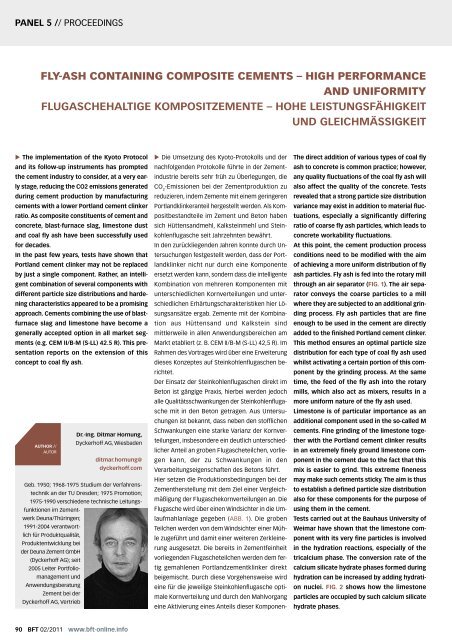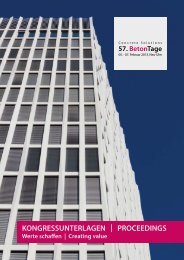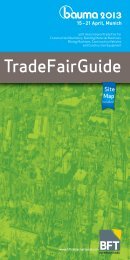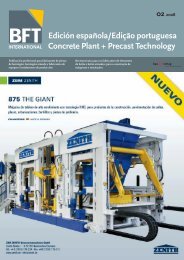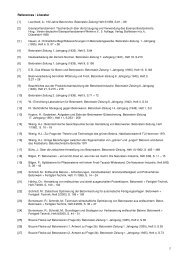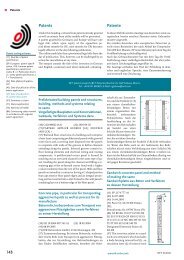Tagungsband - BFT International
Tagungsband - BFT International
Tagungsband - BFT International
Sie wollen auch ein ePaper? Erhöhen Sie die Reichweite Ihrer Titel.
YUMPU macht aus Druck-PDFs automatisch weboptimierte ePaper, die Google liebt.
PANEL 5 // PROCEEDINGS<br />
� The implementation of the Kyoto Protocol<br />
and its follow-up instruments has prompted<br />
the cement industry to consider, at a very ear-<br />
ly stage, reducing the CO2 emissions generated<br />
during cement production by manufacturing<br />
cements with a lower Portland cement clinker<br />
ratio. As composite constituents of cement and<br />
concrete, blast-furnace slag, limestone dust<br />
and coal fly ash have been successfully used<br />
for decades.<br />
FLY-ASH CONTAINING COMPOSITE CEMENTS – HIGH PERFORMANCE<br />
AND UNIFORMITY<br />
FLUGASCHEHALTIGE KOMPOSITZEMENTE – HOHE LEISTUNGSFÄHIGKEIT<br />
UND GLEICHMÄSSIGKEIT<br />
In the past few years, tests have shown that<br />
Portland cement clinker may not be replaced<br />
by just a single component. Rather, an intelli-<br />
gent combination of several components with<br />
different particle size distributions and harde-<br />
ning characteristics appeared to be a promising<br />
approach. Cements combining the use of blast-<br />
furnace slag and limestone have become a<br />
generally accepted option in all market seg-<br />
ments (e.g. CEM II/B-M (S-LL) 42.5 R). This pre-<br />
sentation reports on the extension of this<br />
concept to coal fly ash.<br />
AUTHOR //<br />
AUTOR<br />
Dr.-Ing. Ditmar Hornung,<br />
Dyckerhoff AG, Wiesbaden<br />
ditmar.hornung@<br />
dyckerhoff.com<br />
Geb. 1950; 1968-1975 Studium der Verfahrens-<br />
technik an der TU Dresden; 1975 Promotion;<br />
1975-1990 verschiedene technische Leitungs-<br />
funktionen im Zement-<br />
werk Deuna/Thüringen;<br />
1991-2004 verantwort-<br />
lich für Produktqualität,<br />
Produktentwicklung bei<br />
der Deuna Zement GmbH<br />
(Dyckerhoff AG); seit<br />
2005 Leiter Portfolio-<br />
management und<br />
Anwendungsberatung<br />
Zement bei der<br />
Dyckerhoff AG, Vertrieb<br />
90 <strong>BFT</strong> 02/2011 www.bft-online.info<br />
� Die Umsetzung des Kyoto-Protokolls und der<br />
nachfolgenden Protokolle führte in der Zement-<br />
industrie bereits sehr früh zu Überlegungen, die<br />
CO 2 -Emissionen bei der Zementproduktion zu<br />
reduzieren, indem Zemente mit einem geringeren<br />
Portlandklinkeranteil hergestellt werden. Als Kom-<br />
positbestandteile im Zement und Beton haben<br />
sich Hüttensandmehl, Kalksteinmehl und Stein-<br />
kohlenflugasche seit Jahrzehnten bewährt.<br />
In den zurückliegenden Jahren konnte durch Un-<br />
tersuchungen festgestellt werden, dass der Port-<br />
landklinker nicht nur durch eine Komponente<br />
ersetzt werden kann, sondern dass die intelligente<br />
Kombination von mehreren Komponenten mit<br />
unterschiedlichen Kornverteilungen und unter-<br />
schiedlichen Erhärtungscharakteristiken hier Lö-<br />
sungsansätze ergab. Zemente mit der Kombina-<br />
tion aus Hüttensand und Kalkstein sind<br />
mittlerweile in allen Anwendungsbereichen am<br />
Markt etabliert (z. B. CEM II/B-M (S-LL) 42,5 R). Im<br />
Rahmen des Vortrages wird über eine Erweiterung<br />
dieses Konzeptes auf Steinkohlenflugaschen be-<br />
richtet.<br />
Der Einsatz der Steinkohlenflugaschen direkt im<br />
Beton ist gängige Praxis, hierbei werden jedoch<br />
alle Qualitätsschwankungen der Steinkohlenfluga-<br />
sche mit in den Beton getragen. Aus Untersu-<br />
chungen ist bekannt, dass neben den stofflichen<br />
Schwankungen eine starke Varianz der Kornver-<br />
teilungen, insbesondere ein deutlich unterschied-<br />
licher Anteil an groben Flugascheteilchen, vorlie-<br />
gen kann, der zu Schwankungen in den<br />
Verarbeitungseigenschaften des Betons führt.<br />
Hier setzen die Produktionsbedingungen bei der<br />
Zementherstellung mit dem Ziel einer Vergleich-<br />
mäßigung der Flugaschekornverteilungen an. Die<br />
Flugasche wird über einen Windsichter in die Um-<br />
laufmahlanlage gegeben (ABB. 1). Die groben<br />
Teilchen werden von dem Windsichter einer Müh-<br />
le zugeführt und damit einer weiteren Zerkleine-<br />
rung ausgesetzt. Die bereits in Zementfeinheit<br />
vorliegenden Flugascheteilchen werden dem fer-<br />
tig gemahlenen Portlandzementklinker direkt<br />
beigemischt. Durch diese Vorgehensweise wird<br />
eine für die jeweilige Steinkohlenflugasche opti-<br />
male Kornverteilung und durch den Mahlvorgang<br />
eine Aktivierung eines Anteils dieser Komponen-<br />
The direct addition of various types of coal fly<br />
ash to concrete is common practice; however,<br />
any quality fluctuations of the coal fly ash will<br />
also affect the quality of the concrete. Tests<br />
revealed that a strong particle size distribution<br />
variance may exist in addition to material fluc-<br />
tuations, especially a significantly differing<br />
ratio of coarse fly ash particles, which leads to<br />
concrete workability fluctuations.<br />
At this point, the cement production process<br />
conditions need to be modified with the aim<br />
of achieving a more uniform distribution of fly<br />
ash particles. Fly ash is fed into the rotary mill<br />
through an air separator (FIG. 1). The air sepa-<br />
rator conveys the coarse particles to a mill<br />
where they are subjected to an additional grin-<br />
ding process. Fly ash particles that are fine<br />
enough to be used in the cement are directly<br />
added to the finished Portland cement clinker.<br />
This method ensures an optimal particle size<br />
distribution for each type of coal fly ash used<br />
whilst activating a certain portion of this com-<br />
ponent by the grinding process. At the same<br />
time, the feed of the fly ash into the rotary<br />
mills, which also act as mixers, results in a<br />
more uniform nature of the fly ash used.<br />
Limestone is of particular importance as an<br />
additional component used in the so-called M<br />
cements. Fine grinding of the limestone toge-<br />
ther with the Portland cement clinker results<br />
in an extremely finely ground limestone com-<br />
ponent in the cement due to the fact that this<br />
mix is easier to grind. This extreme fineness<br />
may make such cements sticky. The aim is thus<br />
to establish a defined particle size distribution<br />
also for these components for the purpose of<br />
using them in the cement.<br />
Tests carried out at the Bauhaus University of<br />
Weimar have shown that the limestone com-<br />
ponent with its very fine particles is involved<br />
in the hydration reactions, especially of the<br />
tricalcium phase. The conversion rate of the<br />
calcium silicate hydrate phases formed during<br />
hydration can be increased by adding hydrati-<br />
on nuclei. FIG. 2 shows how the limestone<br />
particles are occupied by such calcium silicate<br />
hydrate phases.


